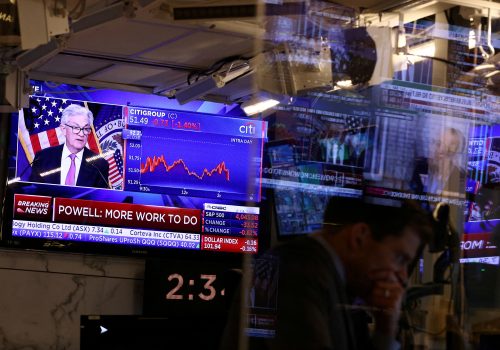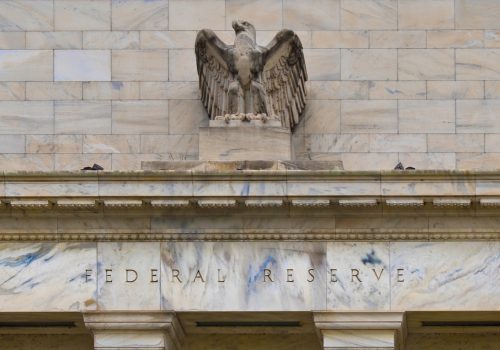March 30, 2023
Chinese banking’s SVB resilience
In 2009, during the depths of the Global Financial Crisis, Chinese Premier Wen Jiabao gave a speech to the leaders of global finance. Looking out over the room, he told an anxious audience, “The crisis has inflicted far-reaching impacts on the world economy—and China’s economy has not been immune.”
He expressed the Chinese Communist Party’s (CCP) surprise and unease over how problems reverberating from the US financial sector hurt China and promised to re-examine the Chinese financial sector’s linkages to the US. He then announced the party’s new strategic priority to refocus Chinese finance on its domestic economy as a way to tackle the crisis and stave off future shocks from overseas.
At the time, the declaration went largely unnoticed. There were too many other problems to deal with. But nearly fifteen years later, as the global economy confronts another wave of bank failures, it’s clear China followed through on Wen’s promise.
The effects of Silicon Valley Bank’s (SVB) and Credit Suisse’s collapse have reverberated across every major economy—except one. The KBW Nasdaq Bank Index, which tracks the performance of the world’s leading Globally Systemically Important Banks (G-SIBS) is down 17 percent from March 7 to its trough on March 24. China, however, remains an outlier. Why?
Scars of the Great Recession
2008 was a turning point in China’s liberalization of its financial sector. The crisis exposed what Beijing perceived to be unacceptable cross-border risks between the United States and China. The collapse of Lehman Brothers shocked China’s leaders. Not because they were overly concerned about contagion—they had fiscal and monetary tools to deal with the immediate economic problems. But because they saw that the United States was willing to let its major financial institutions fail. This made connections to the US system overly risky.
The Great Recession also forced the CCP to reassess the model it would structure its financial system around. The crisis revealed a more volatile and risky face of Western banking. Leading government-affiliated scholars became increasingly skeptical of a market approach to finance, which they saw as driving financial instability in the United States and Europe.
China’s immediate response to the crisis was to rely on its state-owned banks. In conjunction with a massive fiscal stimulus program, Beijing instructed these institutions to substantially increase lending. Total domestic credit grew by more than one-third in 2009. It was through these state-owned banks and enterprises that China’s real economy—unlike Western economies—escaped relatively unscathed by the financial crisis and maintained employment despite a collapse of global trade.
As China recovered from the recession, the dominant perception among policy makers and influential scholars became that insufficiently regulated financial markets caused the crisis. State-ownership, on the other hand, was fundamental to ensuring China could weather and then quickly exit it.
These lessons laid the foundation for policy changes that have insulated the Chinese banking system from the collapse of SVB and Credit Suisse.
Banking with Chinese characteristics
While 2008 forced Chinese policy makers to recognize these risks, other priorities delayed any action. They still wanted to integrate some parts of their economy into the global financial system such as including the Yuan in the IMF’s Special Drawing Right (SDR) basket. It was only in the later part of the decade, following its 2015 stock market crash that Beijing began implementing this policy pivot.
In 2015 the pop of a market bubble saw the Shanghai Stock Exchange lose more than 48 percent of its overall value. After the incident, financial regulation was named a top political priority at the 2017 National Financial Work Conference, a twice-a-decade event which set the scene for the country’s financial sector for the next five years.
In the ensuing months, Beijing appointed a new top bank regulator who began implementing a “windstorm” of new regulations. In order to de-risk the sector, policymakers tightened controls on cross-border transactions, capital movement, and overall exposure to other markets. The following year Beijing also drew banks closer to the state. Regulators pushed banks to establish Communist Party Committees with a wide oversight purview. Most were formed with the stipulation that they would be consulted before corporate strategy was agreed upon. As our China Pathfinder project, a collaboration with Rhodium Group, shows, this—in conjunction with other measures—has led to a financial system with intense state supervision.
These reforms, as well as the banking structure that predated them, has generated major differences between China and Western approaches to banking. China has a high level of state ownership and control of its banking sector, and a government that more actively intervenes in banking decisions.
As Premier Jiaboa promised, the result is a banking sector that is exceptionally focused on China’s domestic economy and adverse to cross-border risk, especially from Western economies. In 2021 cross-border lending of Chinese banks represented less than 5 percent of their total balance sheet. In the United States, cross-border lending constitutes more than 22 percent of its banks’ balance sheets. What little cross-border lending China does engage in is focused on emerging and developing economies. This lending can often be understood as a policy choice serving strategic goals, such as the Belt and Road Initiative.
These policy choices have led to a financial system with more immunity to the problems facing the United States and Europe. While the collapse of Credit Suisse and SVB reverberated across all major Western financial capitals, China, with the world’s largest banking sector, was largely unimpacted.
But that protection comes with its own costs.
First, Chinese finance is continually plagued with inefficient capital allocation. This is prominently playing out in the semiconductor industry with reports that senior officials are increasingly angry at the lack of development progress despite the tens of billions of dollars they have funneled into the industry over the past decade. Second, China’s lack of international and advanced economy banking connections mean it plays an undersized role in global banking standard setting such as the Basel Committee. For a country that has promised more international leadership in recent years, its lack of a large international financial presence often precludes it a seat at the rulemaking table (time will tell if China’s ambitions toward Hong Kong change this dynamic). Finally, its banking system is unable to offer Chinese savers attractive investment products, leading to other economic imbalances—including an asset price bubble in the country’s property sector.
Similar to China’s zero-COVID policy, financial isolation comes with tradeoffs. While it may create a system that is relatively unphased by crises abroad, it also can generate and amplify endogenous issues within China’s own economy.
Josh Lipsky is the senior director of the Atlantic Council’s GeoEconomics Center and a former adviser at the International Monetary Fund.
Niels Graham is an Assistant Director with the Atlantic Council GeoEconomics Center focusing on the Chinese economy.
The authors would like to thank GeoEconomics Center YGP Phillip Meng for his excellent research support.

At the intersection of economics, finance, and foreign policy, the GeoEconomics Center is a translation hub with the goal of helping shape a better global economic future.
Further reading
Thu, Mar 16, 2023
It’s not 2008: Keep calm as central banks carry on
New Atlanticist By Josh Lipsky
This week's financial drama may look familiar, but the world's financial firefighters have been preparing for this moment for nearly fifteen years.
Mon, Mar 13, 2023
Silicon Valley Bank failed: What happens next?
EconoGraphics By Hung Tran
Even if the contagion effects are contained, risks to the financial stability of the US and the world have increased significantly. The Fed can no longer focus only on bringing down inflation, but must also avoid exacerbating financial stability risks.
Mon, Mar 20, 2023
The Federal Reserve’s dilemma: Choosing between monetary policy and financial stability
Econographics By Barbara C. Matthews
The monetary-policy challenge that the Fed faces now cannot be overestimated.
Image: The Bund (rhymes with ‘fund’) Financial Square features a bull statue (installed 2010) by sculptor Arturo Ugo Di Modica who also did the Wall Street Charging Bull in New York (from 1989). In the background on the left is The Hongkong & Shanghai Banking Corporation [known now as HSBC] Building completed in 1923 which houses the Shanghai Pudong Development Bank today. On the right with the clock tower is the Customs House built in 1927. Photo: Dan Lundberg/Wikicommons


